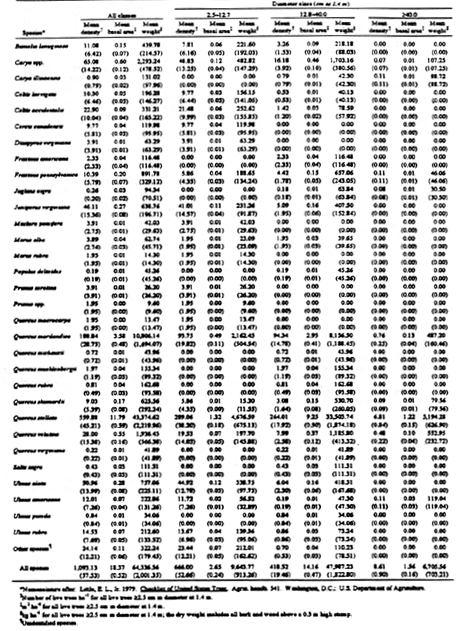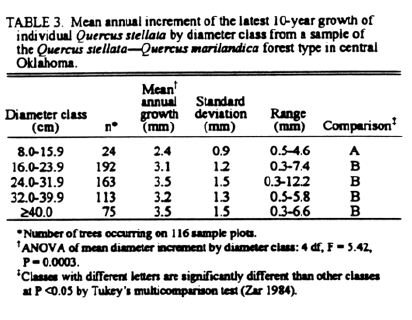
| Great Lakes Ecosystems | ||

|
|
|||||||||
|
1994
Proceedings
|
|
QUERCUS STELLATA GROWTH AND STAND
CHARACTERISTICS IN THE QUERCUS STELLATA-QUERCUS MARILANDICA FOREST
TYPE IN THE CROSS TIMBERS REGION OF CENTRAL OKLAHOMA
James F. Rosson, Jr. |
 |
The forests of the Cross Timbers region of Oklahoma have long been considered commercially unproductive for wood products. Recent increasing interest in the commercial utilization of this timber resource has heightened concerns by the Oklahoma Division of Forestry (ODF) on how to best manage and protect the resource. Subsequently, a baseline forest survey of central and west Oklahoma was conducted by the USDA Forest Service, Southern Forest Experiment Station in cooperation with the USDA Soil Conservation Service (SCS) and the ODF (Rosson, In press) to obtain growth and volume estimates and to provide other pertinent data for exploring management options.
Tree and stand growth rates are important in determining harvest sustainability of the resource. This study focused on the Quercus stellata—Quercus marilandica forest type in the Cross Timbers region to determine stand structure and growth characteristics of this type at the western limit of upland tree growth. Quercus stellata diameter growth was also analyzed to determine if there was any relationship among the rate of diameter growth, tree size, and stand basal area.
Potential natural vegetation of the Cross Timbers region is open stands of trees with an understory of mid and tall grasses, forbs, and low woody plants. Quercus stellata and Quercus marilandica are the dominant tree species; Andropogon gerardi, A. scoparius, Sorghastrum nuttans, Helianthus spp., and Lespedeza spp. are the major species in the understory. Average annual precipitation is 62.5 cm in the west to 90.0 cm in the east, with maximum precipitation in the spring and minimum in the winter. The average annual temperature is 15 to 17o C and the average freeze-free period is 190 to 240 days. The major soils are Ustalfs and Ochrepts. Elevation ranges from 300 to 400 m; topography is rolling to moderately hilly (SCS 1981).
A subset of the randomly located 1982 Natural Resources Inventory (NRI) plots established by the SCS (Rosson, in press) were selected to depict forest conditions that occur for this forest type, on average, in 34 counties across the Cross Timbers region. Plot selection, for this study, was based on the following criteria: the stand had to be a Quercus stellata—Quercus marilandica forest type, > 0.4 ha in area, forest cover _10 percent, and > 50 percent of stand basal area in trees _12.7 cm in diameter 1.4 m above ground line (DBH). Of 387 plots, 116 plots were selected using these criteria.
Five points spaced 20 m apart were established at each plot. At each point, trees _ 12.7 cm in DBH were selected with an 8.6 (m2/ha) basal area factor prism . Thus, each tree selected across the 5 point design represented 1.7 m2/ha. Trees _ 2.5 but < 12.7 cm in DBH were sampled on 2.16 m radius subplots (1/680 ha) at points 1, 2, and 3. The 10-year periodic annual growth was determined by boring each sample tree. Only data pertaining to trees were obtained (seedlings through tree-size); abiotic, shrub, and herbaceous data were not collected. For additional details on the sample see Rosson (in press). Analysis of variance (ANOVA) and a posteriori multi-comparison testing of diameter increment for Quercus stellata were done with SAS routines (SAS 1985).
At least 31 tree species were recorded in the sample. Quercus stellata occurred on 109 plots, and Quercus marilandica, on 67 plots. Carya (57 trees on 33 plots) and Prunus (1 tree) were identified to genus only; additionally, there were 15 unidentified trees on 7 plots. In all, 1,400 trees _ 2.5 cm in DBH were tallied on 116 plots. Nineteen species occurred on < 5 sample plots, and 17 species were represented by < 5 sample trees. This resulted in a large standard error for several attributes of some individual species (Table 1).
The average basal area for these stands across the Cross Timbers region was 18.4 m2/ha (range = 7.9 to 33.4 m2/ha for n = 116). Quercus stellata accounted for 64 percent of the basal area followed by Quercus marilandica (19 percent). Carya spp., Quercus velutina, Ulmus alata, and Juniperus virginiana made up an additional 3, 3, 2, and 2 percent of basal area, respectively. Thus, six species accounted for 93 percent of basal area in these stands. Seventy-seven percent of basal area was in the 12.8 to 40.0 cm diameter range.
Dry weight of bark and wood for all trees _ 2.5 cm in DBH averaged 64,337 kg/ha. The net volume of bole wood averaged 47.8 m3/ha for all live trees and 26.8 m3/ha for growing-stock trees. Stand growth for trees _12.7 cm in DBH was 0.14 m3ha for growing-stock and 1.14 m3/ha for all live trees (Table 2).
A total of 567 Quercus stellata trees _ 8.0 cm in DBH were measured and bored on all sample plots. Average diameter increment for the latest 10-year period was 3.2 mm yr. The trees were stratified by diameter class and ANOVA tests were conducted to identify significant differences between the classes (Table 3). Tukey's multi-comparison test was then done to identify any significant classes. Only the 8.0 to 15.9 cm DBH class was significantly different from the other classes. An ANOVA was also done on the growth increment stratified by stand basal area class. Although the ANOVA was significant, no discernible stratum was detected by the Tukey multi-comparison test (Table 4).
The study stands are dominated by Quercus stellata and, to a lesser extent, Quercus marilandica. Most are recovering from past disturbance consisting of cutting, fire, and grazing (Pat McDowell, ODF, pers. comm.). Based on the borings of 212 arbitrarily selected and dominant Quercus stellata trees, average age of these stands is 51 years. Even though the oldest Quercus stellata bored was 165 years old, it appears that most of these stands cannot be construed as old growth. However, some stands may indeed qualify as old-growth and await further study.
Average stand growth (1.1 m3/ha/yr) is less than that required to be classed as a commercially sustainable forest (1.4 m3/ha/yr as defined by the USDA Forest Service). Individual tree size and stand basal area did not appear to be influencing diameter increment in Quercus stellata. Although both diameter and stand basal area class tests were significant, only one class was detected in the a posteriori multi-comparison test indicating that the ANOVA was more sensitive than the Tukey test (Zar 1984). Even if a more sensitive test was available, the results are not likely to be biologically important (Krebs 1989) as evidenced by the small difference between the means. In addition, a test of the interaction between stand basal area and diameter class was not successful because the number of trees in each stratum became inadequately small.
Further studies should explore the climatic and edaphic influence (rather than stand density) on the diameter growth of Quercus stellata (or an interaction between the two) at the western edge of upland tree growth. It is not likely that tree density control by managers will increase stand productivity. Some timber volume is available in these stands. However, slow growth rates, as indicated by this study, dictate careful implementation of the commercial extraction of wood products from this forest type in the Cross Timbers region.
Krebs, C. J. 1989. Ecological Methodology. Harper Collins, New York, NY.
Rosson, J. F., Jr. The timberland and woodland resources of central and west Oklahoma. Resource Bulletin by the U.S. Department of Agriculture, Forest Service, Southern Forest Experiment Station, New Orleans, LA. In press.
SAS Institute. 1985. SAS User's Guide: Statistics. Version 5 ed.. SAS Institute, Cary, North Carolina.
SCS. 1981. Land Resource Regions and Major Land Resource Areas of the United States. Agriculture Handbook 296. U. S. Department of Agriculture. Soil Conservation Service, Washington, D. C.
Zar, J. H. 1984. Biostatistical Analysis. Second edition. Prentice-Hall, Englewood Cliffs, New Jersey, USA.

TABLE 1. Density, basal area and dry weight by species as a sample of the Quercus Stellata-Quercus Marilandica forest type in central Oklahoma; means are reported to 1 standard error (in parenthesis) ; n = 116


